Contact Lenses and Care
How to Remove Your Contact Lenses
7 mins read
It’s the end of the day. Or perhaps you just feel it’s time to remove your lenses and change to glasses, for whatever reason. Having mastered how to put in your contact lenses, now it’s time to remove them and care for your lenses. Worry not: here’s what you need to do next.
As with applying lenses, removing them starts with clean hands. Wash them well, and then it’s ‘clean towel’ time. Ideally this is a microfiber, lint-free towel which has been washed several times before, removing the fluff that comes with a new one. Doing this will ensure you don’t add any dirt particles whilst removing the lens. As with insertion, some people prefer standing in front of a mirror, others to sit and use a mirror laid flat on the table. Go with whatever works for you.
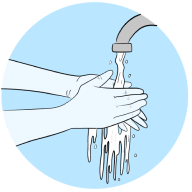

Wash hands with pH neutral soap.
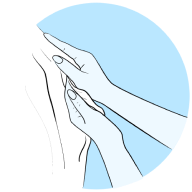

Dry hands with lint-free towel.
Before taking out your lenses, prepare their destination. If you use daily disposable contact lenses, all you need is a trash can close by. If, however, you use monthly replacement lenses, have your empty lens case nearby, plus your bottle of fresh contact lens solution. Make sure the area around you is clean and tidy.
Removing a lens is even easier than putting one in. Use your index or middle finger to pull up your upper eyelid and thumb to stretch down the lower one. This overcomes your natural desire to blink, whilst keeping your eye wide open. Take a look in the mirror. Yes, there’s a slightly mad-looking person staring back at you, with their mouth like a fish. That’s you, about to take out your lenses.
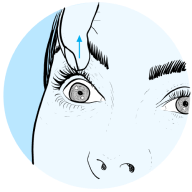

With one hand, raise the upper eyelid.
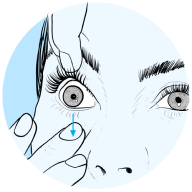

Use your 2nd arm to pull the lower lid. Keep your index finder ready to tap on the contact lens.
With your free hand, place your index finger onto the lens, just below your pupil—the black hole at the center of the iris (the colored part of your eye). Slide the lens down onto the white of your eye, while looking slightly upwards. Then, using the index finger and thumb of the same hand, pinch the lens gently, lifting it from your eye. Work with the sides or pads of your fingers, keeping your fingernails well away from your eyeball. As long as you’re careful and keep your fingernails clear, the lens and your eye will both escape any damage.
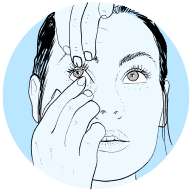

Tap at the center of pupil with your index finger. Slide the contact lens to lower part of your eye.
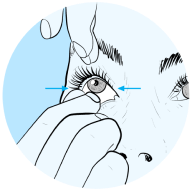

Pinch the lens between your index finger and thumb. Take out the lens.
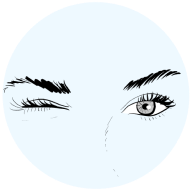

Blink a few times. Dispose of the contact lens or follow care instructions (if using monthly contact lenses).
Having prepared in advance, you’re now ready for the next step. If it’s a daily disposable, as the name suggests, you can dispose of it in the bin. If it’s a monthly replacement lens, it won’t be damaged by removal, but it will no longer be clean, having spent a day in your eye and a few seconds on your fingers. So you need to cleanse it, before storing it in its case.
Do this in line with the instructions of your lens care solution. This is likely to tell you to put the contact lens in your palm and spray it with contact lens cleaning solution. Then lightly rub each side of the contact lens with your fingers for 15-20 seconds, to get it clean. Give it a final rinse to remove any remaining debris and place the lens in the appropriate half of the case (it will be marked L for left and R for right). Fill with fresh solution and close the lid, before repeating with the other eye and lens.
Now you seem like a sensible person, but it’s worth underlining one obvious point: never use tap water to clean your lenses or contact lens case, as this can lead to serious eye infections. Only use proper cleaning solution. Saliva does not fit that definition!
Having removed the first lens, don’t forget to do exactly the same with your other eye. Sometimes you may find yourself a little distracted, tipsy or forgetful. You wouldn’t be the first person to wonder if you’ve taken no lenses out, one, or both.
‘One in, one out’ is unlikely to do you any lasting harm—but you could irritate or damage your eyes (or bump into the furniture!). If in doubt, cover one eye and check whether you can see clearly. If yes, you’re still wearing a lens on your uncovered eye. Take it out!
Your contact lenses are now ready for their disinfecting overnight soak.

No, you cannot. It’s physically not possible. So please, take a deep breath—and relax. We’re glad to tell you it cannot happen, thanks to a skin layer (the conjunctiva) which forms a barrier that the lens cannot pass. So here’s what to do if you can’t locate a lens.
First off, cover your other eye. If you can see better than you would have done without a lens in, you’ve confirmed the lens is still there. Now blink a few times, before taking another pinch. Your lenses are usually right where you left them and will disengage easily.
However, if one has rolled up your eyeball and got stuck, find it by pressing gently against your closed upper eyelid, while rubbing it towards your nose. In a moment or two, the hidden lens will reappear from under your eyelid, in the center of your eyelid or near to your nose, ready to be removed.
Lenses are thin, well-fitting miracles of comfort and clarity. Sometimes though, especially when you are tired, your coordination may not be at its best and your lens will play hard to find.
Don’t worry. As long as your hands are clean and you keep your nails out of the way, you won’t do yourself any harm fishing for it.
So, with everything working as normal, here’s how to remove the lens. Make sure your hands are extra dry. Take a breath, blink a few times, then pinch your finger and thumb from the extreme corners of your eye, while looking directly into the mirror. Never use your nails as pincers: just use your fingertips or the sides of your fingers.
Once you locate the edges of your lens, you should be fine. However, if your eyes get particularly dry, you may want to keep rewetting eye drops on hand, to help lubricate the lenses before removal. Make sure these are suitable for contact lenses (your optician can advise you).
Alternatively, look slightly up, place your index (pointing) finger on the lens, just below your pupil. Press gently, look up and move your thumb towards your index finger, folding the lens between both. Then lift off the lens.
If this all sounds complicated, it isn’t.
Everything we’ve covered above can be summarised simply as: “Wash and dry hands. Pull eyelids apart. Pinch lens gently from both sides with finger and thumb pads - not nails - to remove it. Clean, store or throw away. Repeat.”
You may also want to remove your lenses before swimming, or a visit to a hot tub/shower. We recommend you do so.
‘However, if you decide to wear them in the water, make sure you use swimming goggles in the pool and keep your eyes closed under the shower. Water carries all sorts of bacteria and other materials that can cause eye infections. With daily disposable contact lenses, wait for 20 minutes after swimming, then put in a fresh pair.

With monthly replacement lenses, rub and rinse them with a multipurpose solution—also 20 minutes after swimming. It is important to disinfect the contact lenses prior to reinsertion. This gives your tears the time needed to blink away chlorine and get rid of the many invisible microbes with which you’ve been sharing your water.
As with handling your contact lenses, it’s important to keep your monthly contact lens case clean. This means emptying it after each overnight soak, then wiping it clean with a lint-free cloth, and letting it dry naturally.
Add fresh contact lens cleaning solution when you put your monthly lenses in the case each night, preventing any chance of contamination. Then replace the lens case every two or three months—or use any free case that comes with your new supply of contact lens solution.
That way, you’ll continue to enjoy trouble-free contact lens wear.
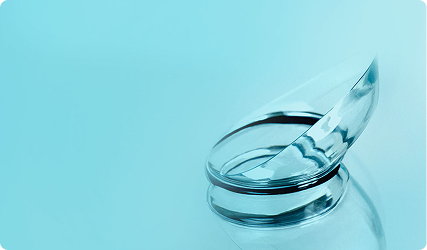

DAILIES TOTAL1™ MULTIFOCAL
See clearly at all distances, near through far,4,5 in a multifocal contact lens that feels like nothing.†6
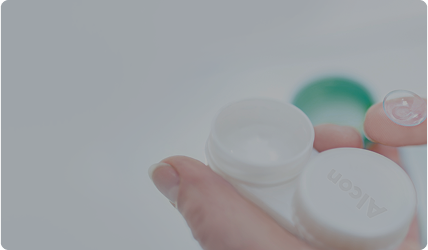

MONTHLY CONTACT LENSES
Monthly replacement contact lenses are reusable contact lenses. After a month, you throw them away and replace them with a fresh new pair.
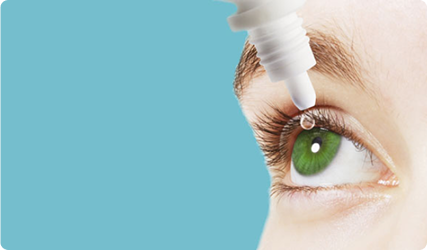

EYE CARE PRODUCTS
From dry eyes, to eye allergies, and optimal eye health— find solutions you need to keep your eyes feeling their best.
ALWAYS READ THE LABEL AND FOLLOW THE DIRECTIONS FOR USE.
All content on this website is for informational purposes only, always talk to your health professional regarding your eye health or medical conditions.